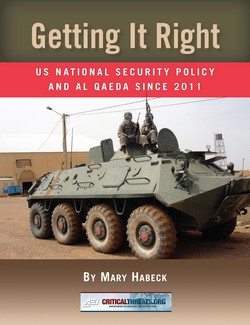{{currentView.title}}
April 24, 2014
Getting it Right: U.S. National Security Policy and al Qaeda Since 2011
 Executive Summary
Executive Summary
Current national security policy is failing to stop the advancement of al Qaeda and its affiliates throughout the Muslim-majority world. While there are many reasons for this failure, three key issues stand out: a poor definition of the enemy, an incorrect view of its objectives, and the adoption of a strategy that will not defeat the latest evolution of this adaptive organization. If the US understood al Qaeda as it is: the leadership and field army of an insurgency with worldwide linkages that hopes to impose its extremist version of shari’a, govern territory, and overthrow the leaders of every Muslim-majority country, the current national strategy for combating al Qaeda would not be confined to counter-terrorism and attrition, but would instead make counterinsurgency—without large numbers of American ground forces—its main technique for confronting and defeating the organization.
 |
The current official definition of al Qaeda is particularly troubling, since this frames the entire problem for the US government. By choosing to understand al Qaeda narrowly as the terrorist group that carried out the 9/11 attacks, the government has decided on an overly legalistic assessment of a far greater problem. It is also troubling that a very careful reading of official statements and published documents is necessary to find this definition, perhaps because if it were more widely known there would be strenuous objections to it. The Obama administration also ignores al Qaeda’s own stated objectives—to impose its extremist version of shari’a and govern territory—to focus solely on its clear desire to attack the United States. By doing so, we are missing the explanation for the vast majority of al Qaeda’s activity around the globe, including its efforts to control territory in places like Yemen, Iraq, Syria, Somalia, and Mali.
The misreading of the enemy and his objectives has led to the adoption of a strategy, centered on counterterrorism, that cannot defeat al Qaeda. The set of techniques known as counterterrorism is ultimately based on attrition—that is, killing or capturing the members of the terrorist group. Counterterrorism and attrition work best against small groups that are incapable of mass recruitment and therefore cannot replace themselves, are unable to hold territory, and lack the capacity to set up shadow governance. None of this is true of al Qaeda today. Given the resurgence of al Qaeda since 2011, one would expect a serious rethinking of US national strategy to combat the group, but so far this has not happened.
Any strategy that would seek to combat the new al Qaeda must begin with a reassessment of the enemy and its objectives and choose a set of techniques that matches this reassessment. A better definition of the enemy would take into consideration its ideology, stated objectives, and military-political strategy and would take seriously the challenge of those affiliated organizations that seek to consciously and continuously implement al Qaeda’s vision in the world. The strategy that would flow from this redefinition would almost certainly include some version of counterinsurgency as well as counterterrorism, both of which would work with and through partners, rather than through American boots on the ground, to implement a coherent and global policy to defeat this growing threat.
Download the full report.
